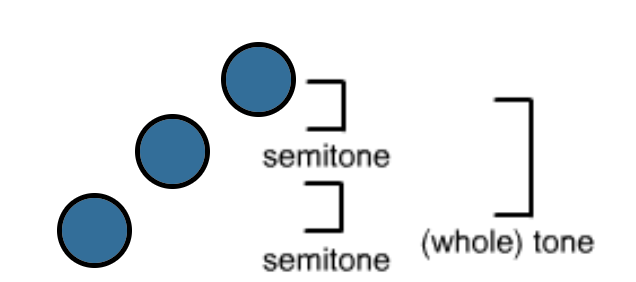 Note Names and the Keyboard
Note Names and the Keyboard
音符名和琴键
Pitch Basics: Note Names and the Keyboard
音高基础:音符名称和琴键
Until now we have simply referred toparticular notes and pitches in the examples as "the highest,""the lowest," or else according to particular words to which theywere sung. Presently, we shall see how musical notes and pitches are morecommonly referred to by letter names. Our introduction to note names will beaided visually through reference to a piano keyboard, a portion of which ispresented below as Example 6. Whereas a full piano keyboard has 88 keys, wehave here shown only 24.
到目前为止,我们只是在例子中提到特定的音符和音高,即“最高的”,“最低的”,或者根据他们所唱的特定的词。目前,我们将看到音符和音高是经常用的字母名称。我们对音符名称的介绍将从视觉上参考一个钢琴键盘,其中一部分在下面作为例子6给出。而一个完整的钢琴键盘有88个键,我们在这里只显示了24个。

Example 6. A segment of a piano keyboard.
例子6.钢琴键盘的一部分。
Pitches on the keyboard ascend by semitonefrom left to right. On the segment of the keyboard presented above, the seriesof ascending semitones follows the pattern (starting at the left): white key,black key, white, black, white, black, white, white, black, white, black,white, white, black, and so on.
琴键上的音高从左到右以半音为单位升高。在上面提到的琴键上,一系列的升序半音符号(从左开始):白键,黑键,白键,黑键,白键,黑键,白键,白键,黑键,白键,黑键,白键,白键,黑键等等。
The white keys (and the pitches they play)are named using the letters A through G. Ascending alphabetical order reflectsascending pitch; after G, the letters recycle, beginning again from A. Pitches(and and piano keys) an octave apart are given the same letter name. Forexample, the key and note labeled F in the middle of the example is an octavehigher than the key labeled F at the far left of the example. Adjacent whitekeys that have an intervening black key (i.e. A-B, C-D, D-E, F-G, G-A) aredistant by a whole tone. The white keys B-C and E-F by contrast have nointervening black key; the intervals between B-C and E-F are semitones.
白键(和它们所播放的音高)用字母A到G来命名。按字母顺序排列反映了上升音高;在G之后,字母从A重新开始循环。相距一个八度的音调(和钢琴键)被赋予相同的字母名称。例如,在示例中间标记为F的键和音符,比在示例最左侧标记为F的键高八度。具有中间黑键(即A-B,C-D,D-E,F-G,G-A)的相邻白键,远离一整个音调。相比之下,白键B-C和E-F没有中间黑键; B-C和E-F之间的音程是半音。
The symbol # (called the sharp sign ) addedto any note name raises the pitch of that note by a semitone. For example, thenote A# (read, "A-sharp") is a semitone higher than the note A. Theblack key just to the right of the white note A plays the note A# . Similarly,the note C#, which sounds a semitone higher than C, is played by the black keyjust to the right of C.
添加到任何音符名称的符号#(称为尖号)以半音为单位提高音符的音高。例如,音符A#(读取“A尖”)比音符A高半音。白色音符A右边的黑键播放音符A#。类似地,音符C#的声音比C高半音,由C右边的黑键播放。
The symbol b (called the flat sign) addedto any note name lowers the pitch of that note by a semitone. For example, thenote Eb (read, "E-flat") is a semitone lower than the note E. Theblack key just to the left of E plays the note Eb. Similarly, the note Bb ,which sounds a semitone lower than B, is played by the black key just to theleft of B.
添加到任何音符名称的符号b(称为平面符号)以半音为单位降低音符的音高。例如,音符Eb(读取“E平”)比音符E低半音。E左边的黑键播放音符Eb。类似地,发出低于B的半音的音符Bb由B左边的黑键来播放。
The alert reader will have noticed that wegave the same black piano key--and for that matter the same pitch--twodifferent names: the black key to the right of A and the left of B is called A#but also Bb. This is not a mistake. The same sound in music can have differentnames--a composer might use one name instead of the other to make the musiceasier for a performer to read, or else (as we will see shortly) to adhere tocertain conventions when writing music in a particular key. Other identicallysounding notes have different names: F# versus Gb, G# versus Ab. Differentlynamed notes that have the same sound are said to be enharmonically related.
有警觉的读者会注意到,我们给了相同的黑色琴键 - 就此而言,相同的音调 - 两个不同的名字:A右边和B左边的黑键叫做A#和Bb。这不是一个错误。音乐中的相同声音可以有不同的名称 - 作曲家可以使用一个名称而不是另一个来使音乐更易于演奏者阅读,或者(正如我们会很快发现)在特定的键写入音乐时会遵循某些约定。其他相同的音符有不同的名字:F#与Gb,G#与Ab。据说声音相同而命名不同的音符被称为是等音的。
NOTE: when one talks about all notes namedC, or all notes named F#, rather than any particular C or particular F#, onesometimes refers to the tone C or the tone F#. Observe that in this case, tonedoes not refer to the specific interval of whole tone, but to a class of notesor pitches. Tone is a word that unfortunately has accumulated many meaningsover its thousands of years in musical usage.
注意:当一个人谈到名称为C的所有音符,或所有名为F#的音符,而不是任何特定的C或特定的F#时,有时指的是音调C或音调F#。注意在这种情况下,音调并不是指整个音调的具体音程,而是指一类音符或音调。很遗憾的是,在数千年的音乐使用中,音调积累了许多的意义。
 Pitches and Notes
Pitches and Notes














